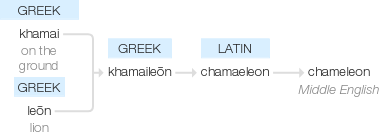Chameleon
Middle English: via Latin chamaeleon from Greek khamaileōn, from khamai ‘on the ground’ + leōn ‘lion’.
wiktionary
From Middle English camelion, from Old French cameleon, from Latin chamaeleon, from Ancient Greek χαμαιλέων(khamailéōn), from χαμαί(khamaí, “on the earth, on the ground”) + λέων(léōn, “lion”); ultimately a calque from Akkadian 𒌨𒈤 𒊭 𒆠(nēšu ša qaqqari, “chameleon, reptile”, literally “lion of the ground", "predator that crawls upon the ground”). The spelling was re-latinized in the early 18th century. The physics sense was coined by Justin Khoury and Amanda Weltman in 2003 in a paper in Physical Review Letters.
etymonline
chameleon (n.)
lizard-like reptile notable for its ability to change color, mid-14c., camelion, from Old French caméléon, from Latin chamaeleon, from Greek khamaileon "the chameleon," from khamai "on the ground" (also "dwarf"), akin to chthon "earth" (from PIE root *dhghem- "earth") + leon "lion" (see lion).
Perhaps the large head-crest on some species was thought to resemble a lion's mane. Greek khamalos meant "on the ground, creeping," also "low, trifling, diminutive." The classical -h- was restored in English early 18c. Figurative sense of "variable person" is 1580s. It formerly was supposed to live on air (as in "Hamlet" III.ii.98). The constellation was one of the 11 added to Ptolemy's list in the 1610s by Flemish cartographer Petrus Plancius (1552-1622) after Europeans began to explore the Southern Hemisphere.
